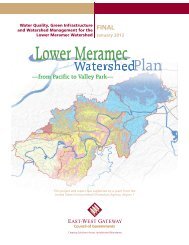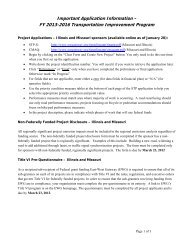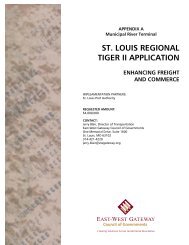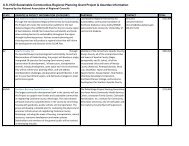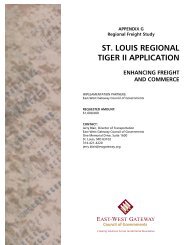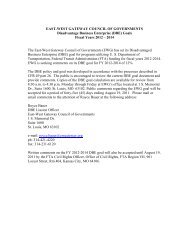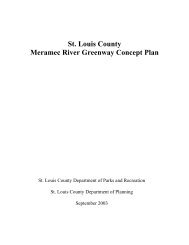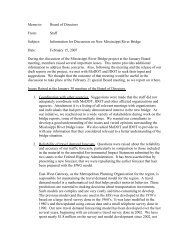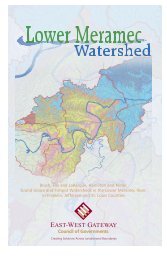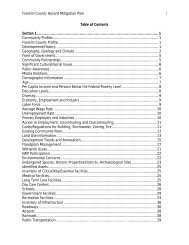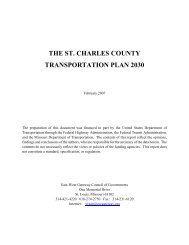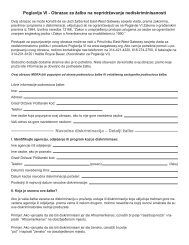Jefferson County - East-West Gateway Coordinating Council
Jefferson County - East-West Gateway Coordinating Council
Jefferson County - East-West Gateway Coordinating Council
Create successful ePaper yourself
Turn your PDF publications into a flip-book with our unique Google optimized e-Paper software.
A Regional Overview All-Hazard Mitigation Plan 99<br />
Asphalt roads soften. Concrete roads have been known to "explode" lifting –three to four<br />
foot pieces of concrete. During the 1980 heat wave hundreds of miles of highways buckled<br />
(NOAA, 1980). Stress is placed on automobile cooling systems, diesel trucks and railroad<br />
locomotives. This leads to an increase in mechanical failures. Train rails develop sun kinks<br />
and distort. Refrigerated goods experience a significant greater rate of spoilage due to<br />
extreme heat.<br />
Various sectors of the agriculture community are affected by extreme heat. Livestock, such<br />
as rabbits and poultry, are severely impacted by heat waves. Millions of birds have been<br />
lost during heat waves. Milk production and cattle reproduction also decreases during heat<br />
waves. Pigs are also adversely impacted by extreme heat. In terms of crop impacts in the<br />
summer of 1980, it is unclear what the impacts are of very high temperatures for a few<br />
days, versus the above average summer temperatures or the drought. We do know that<br />
high temperatures at the wrong time inhibit crop yields. Wheat, rice, corn, potato, and<br />
soybean crop yields can all be significantly reduced by extreme high temperatures at key<br />
development stages.<br />
The electric transmission system is impacted when power lines sag in high temperatures. In<br />
2002 a major west coast power outage impacting 4 states was blamed in part on extreme<br />
high temperatures causing sagging transmission lines to short out. The combination of<br />
extreme heat and the added demand for electricity to run air conditioning causes<br />
transmission line temperatures to rise.<br />
The demand for electric power during heat waves is well documented. In 1980, consumers<br />
paid $1.3 billion more for electric power during the summer than the previous year. The<br />
demand for electricity, 5.5% above normal, outstripped the supply, causing electric<br />
companies to have rolling black outs.<br />
The demand for water increases during periods of hot weather. In extreme heat waves,<br />
water is used to cool bridges and other metal structures susceptible to heat failure. This<br />
causes a reduced water supply and pressure in many areas. This can significantly contribute<br />
to fire suppression problems for both urban and rural fire departments.<br />
The rise in water temperature during heat waves contributes to the degradation of water<br />
quality and negatively impacts fish populations. It can also lead to the death of many other<br />
organisms in the water ecosystem. High temperatures are also linked to rampant algae<br />
growth, causing fish kills in rivers and lakes.<br />
Locations/Areas Affected<br />
Impacts from heat waves are widespread, not selective. Impacts and areas where there are<br />
impacts are dependent upon the weather systems, which affect wide expanses of land.



